Emergency Nursing Care Assessment 2022
VerifiedAdded on 2022/10/08
|6
|1618
|12
AI Summary
Contribute Materials
Your contribution can guide someone’s learning journey. Share your
documents today.
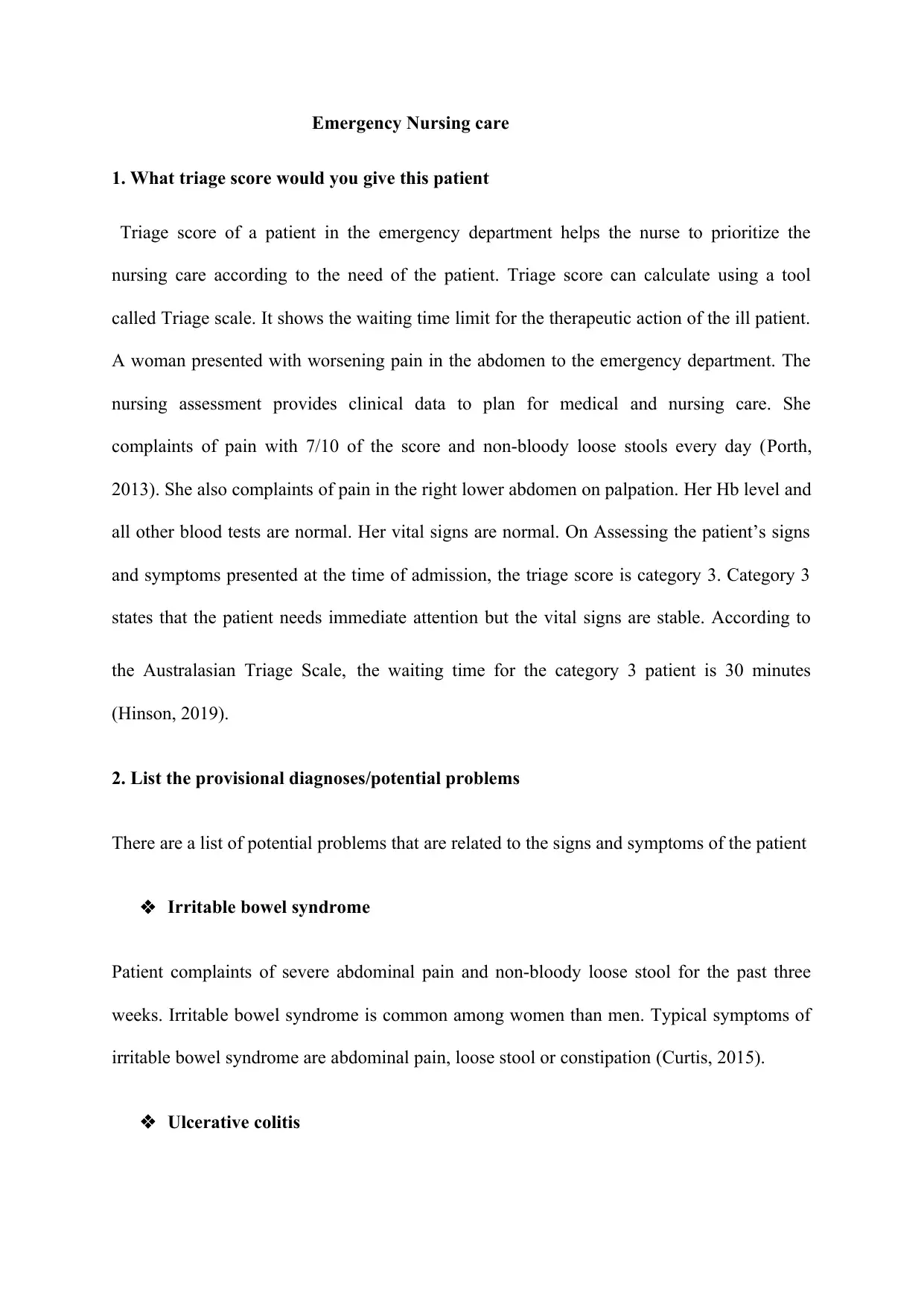
Emergency Nursing care
1. What triage score would you give this patient
Triage score of a patient in the emergency department helps the nurse to prioritize the
nursing care according to the need of the patient. Triage score can calculate using a tool
called Triage scale. It shows the waiting time limit for the therapeutic action of the ill patient.
A woman presented with worsening pain in the abdomen to the emergency department. The
nursing assessment provides clinical data to plan for medical and nursing care. She
complaints of pain with 7/10 of the score and non-bloody loose stools every day (Porth,
2013). She also complaints of pain in the right lower abdomen on palpation. Her Hb level and
all other blood tests are normal. Her vital signs are normal. On Assessing the patient’s signs
and symptoms presented at the time of admission, the triage score is category 3. Category 3
states that the patient needs immediate attention but the vital signs are stable. According to
the Australasian Triage Scale, the waiting time for the category 3 patient is 30 minutes
(Hinson, 2019).
2. List the provisional diagnoses/potential problems
There are a list of potential problems that are related to the signs and symptoms of the patient
Irritable bowel syndrome
Patient complaints of severe abdominal pain and non-bloody loose stool for the past three
weeks. Irritable bowel syndrome is common among women than men. Typical symptoms of
irritable bowel syndrome are abdominal pain, loose stool or constipation (Curtis, 2015).
Ulcerative colitis
1. What triage score would you give this patient
Triage score of a patient in the emergency department helps the nurse to prioritize the
nursing care according to the need of the patient. Triage score can calculate using a tool
called Triage scale. It shows the waiting time limit for the therapeutic action of the ill patient.
A woman presented with worsening pain in the abdomen to the emergency department. The
nursing assessment provides clinical data to plan for medical and nursing care. She
complaints of pain with 7/10 of the score and non-bloody loose stools every day (Porth,
2013). She also complaints of pain in the right lower abdomen on palpation. Her Hb level and
all other blood tests are normal. Her vital signs are normal. On Assessing the patient’s signs
and symptoms presented at the time of admission, the triage score is category 3. Category 3
states that the patient needs immediate attention but the vital signs are stable. According to
the Australasian Triage Scale, the waiting time for the category 3 patient is 30 minutes
(Hinson, 2019).
2. List the provisional diagnoses/potential problems
There are a list of potential problems that are related to the signs and symptoms of the patient
Irritable bowel syndrome
Patient complaints of severe abdominal pain and non-bloody loose stool for the past three
weeks. Irritable bowel syndrome is common among women than men. Typical symptoms of
irritable bowel syndrome are abdominal pain, loose stool or constipation (Curtis, 2015).
Ulcerative colitis
Secure Best Marks with AI Grader
Need help grading? Try our AI Grader for instant feedback on your assignments.
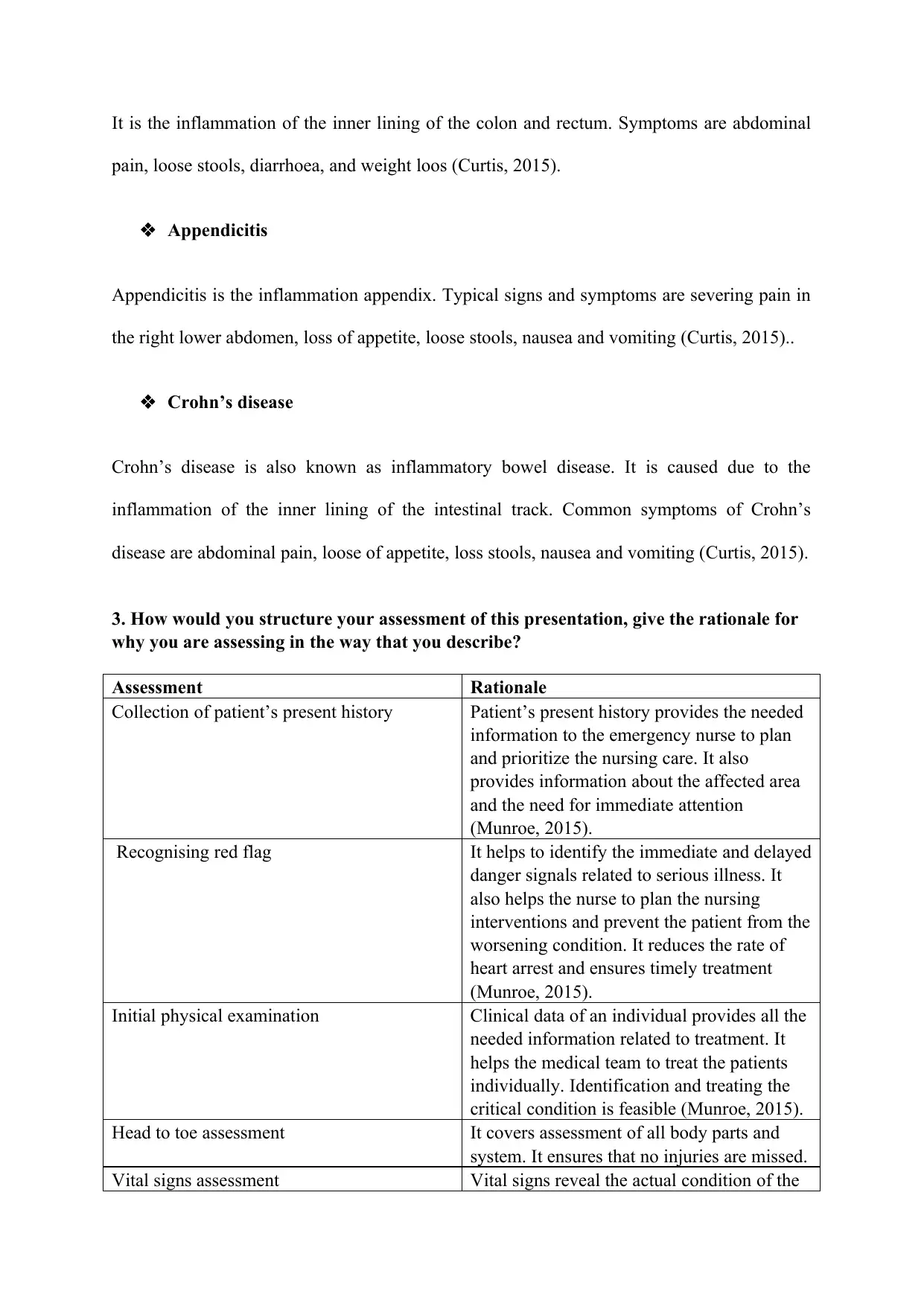
It is the inflammation of the inner lining of the colon and rectum. Symptoms are abdominal
pain, loose stools, diarrhoea, and weight loos (Curtis, 2015).
Appendicitis
Appendicitis is the inflammation appendix. Typical signs and symptoms are severing pain in
the right lower abdomen, loss of appetite, loose stools, nausea and vomiting (Curtis, 2015)..
Crohn’s disease
Crohn’s disease is also known as inflammatory bowel disease. It is caused due to the
inflammation of the inner lining of the intestinal track. Common symptoms of Crohn’s
disease are abdominal pain, loose of appetite, loss stools, nausea and vomiting (Curtis, 2015).
3. How would you structure your assessment of this presentation, give the rationale for
why you are assessing in the way that you describe?
Assessment Rationale
Collection of patient’s present history Patient’s present history provides the needed
information to the emergency nurse to plan
and prioritize the nursing care. It also
provides information about the affected area
and the need for immediate attention
(Munroe, 2015).
Recognising red flag It helps to identify the immediate and delayed
danger signals related to serious illness. It
also helps the nurse to plan the nursing
interventions and prevent the patient from the
worsening condition. It reduces the rate of
heart arrest and ensures timely treatment
(Munroe, 2015).
Initial physical examination Clinical data of an individual provides all the
needed information related to treatment. It
helps the medical team to treat the patients
individually. Identification and treating the
critical condition is feasible (Munroe, 2015).
Head to toe assessment It covers assessment of all body parts and
system. It ensures that no injuries are missed.
Vital signs assessment Vital signs reveal the actual condition of the
pain, loose stools, diarrhoea, and weight loos (Curtis, 2015).
Appendicitis
Appendicitis is the inflammation appendix. Typical signs and symptoms are severing pain in
the right lower abdomen, loss of appetite, loose stools, nausea and vomiting (Curtis, 2015)..
Crohn’s disease
Crohn’s disease is also known as inflammatory bowel disease. It is caused due to the
inflammation of the inner lining of the intestinal track. Common symptoms of Crohn’s
disease are abdominal pain, loose of appetite, loss stools, nausea and vomiting (Curtis, 2015).
3. How would you structure your assessment of this presentation, give the rationale for
why you are assessing in the way that you describe?
Assessment Rationale
Collection of patient’s present history Patient’s present history provides the needed
information to the emergency nurse to plan
and prioritize the nursing care. It also
provides information about the affected area
and the need for immediate attention
(Munroe, 2015).
Recognising red flag It helps to identify the immediate and delayed
danger signals related to serious illness. It
also helps the nurse to plan the nursing
interventions and prevent the patient from the
worsening condition. It reduces the rate of
heart arrest and ensures timely treatment
(Munroe, 2015).
Initial physical examination Clinical data of an individual provides all the
needed information related to treatment. It
helps the medical team to treat the patients
individually. Identification and treating the
critical condition is feasible (Munroe, 2015).
Head to toe assessment It covers assessment of all body parts and
system. It ensures that no injuries are missed.
Vital signs assessment Vital signs reveal the actual condition of the
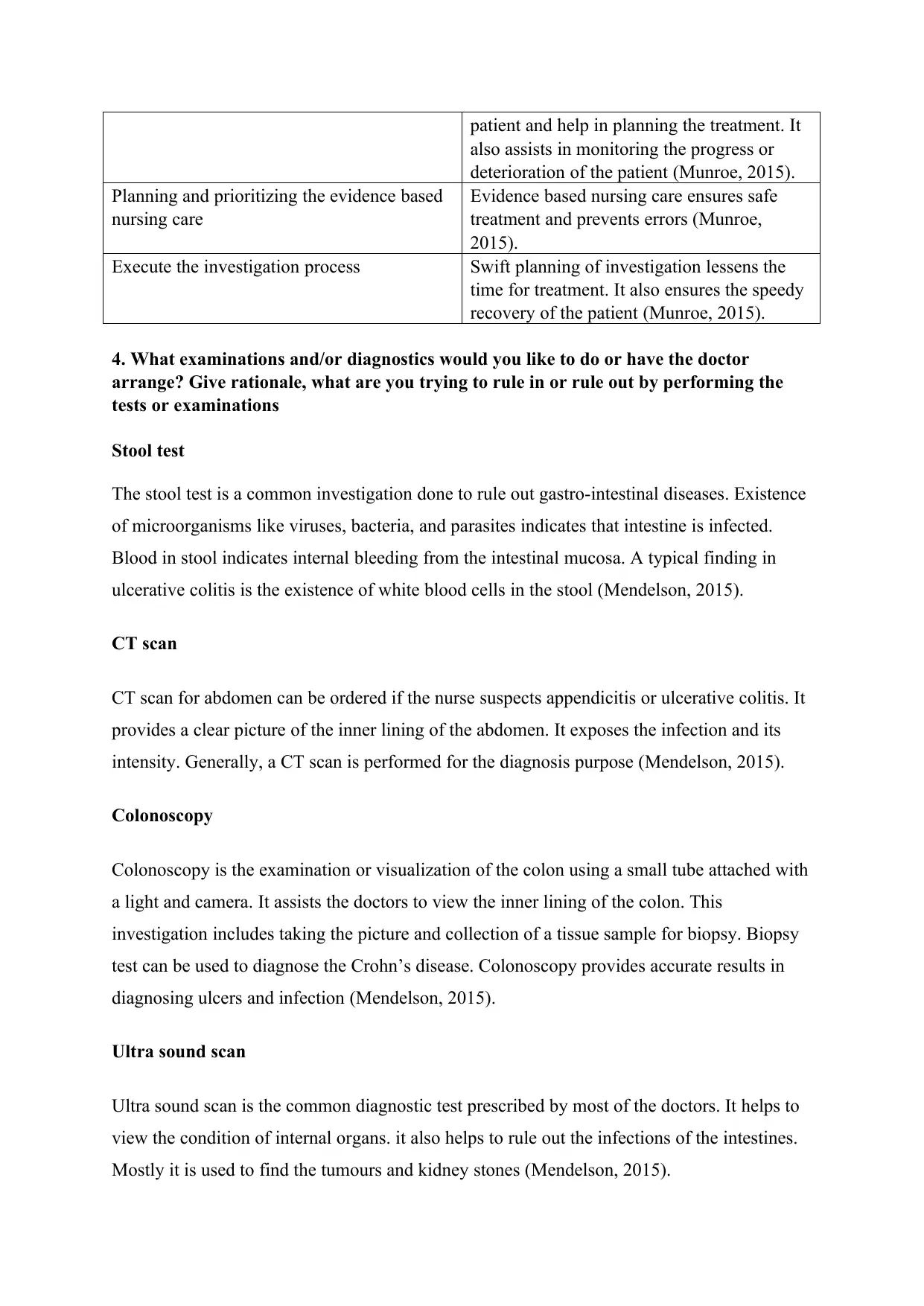
patient and help in planning the treatment. It
also assists in monitoring the progress or
deterioration of the patient (Munroe, 2015).
Planning and prioritizing the evidence based
nursing care
Evidence based nursing care ensures safe
treatment and prevents errors (Munroe,
2015).
Execute the investigation process Swift planning of investigation lessens the
time for treatment. It also ensures the speedy
recovery of the patient (Munroe, 2015).
4. What examinations and/or diagnostics would you like to do or have the doctor
arrange? Give rationale, what are you trying to rule in or rule out by performing the
tests or examinations
Stool test
The stool test is a common investigation done to rule out gastro-intestinal diseases. Existence
of microorganisms like viruses, bacteria, and parasites indicates that intestine is infected.
Blood in stool indicates internal bleeding from the intestinal mucosa. A typical finding in
ulcerative colitis is the existence of white blood cells in the stool (Mendelson, 2015).
CT scan
CT scan for abdomen can be ordered if the nurse suspects appendicitis or ulcerative colitis. It
provides a clear picture of the inner lining of the abdomen. It exposes the infection and its
intensity. Generally, a CT scan is performed for the diagnosis purpose (Mendelson, 2015).
Colonoscopy
Colonoscopy is the examination or visualization of the colon using a small tube attached with
a light and camera. It assists the doctors to view the inner lining of the colon. This
investigation includes taking the picture and collection of a tissue sample for biopsy. Biopsy
test can be used to diagnose the Crohn’s disease. Colonoscopy provides accurate results in
diagnosing ulcers and infection (Mendelson, 2015).
Ultra sound scan
Ultra sound scan is the common diagnostic test prescribed by most of the doctors. It helps to
view the condition of internal organs. it also helps to rule out the infections of the intestines.
Mostly it is used to find the tumours and kidney stones (Mendelson, 2015).
also assists in monitoring the progress or
deterioration of the patient (Munroe, 2015).
Planning and prioritizing the evidence based
nursing care
Evidence based nursing care ensures safe
treatment and prevents errors (Munroe,
2015).
Execute the investigation process Swift planning of investigation lessens the
time for treatment. It also ensures the speedy
recovery of the patient (Munroe, 2015).
4. What examinations and/or diagnostics would you like to do or have the doctor
arrange? Give rationale, what are you trying to rule in or rule out by performing the
tests or examinations
Stool test
The stool test is a common investigation done to rule out gastro-intestinal diseases. Existence
of microorganisms like viruses, bacteria, and parasites indicates that intestine is infected.
Blood in stool indicates internal bleeding from the intestinal mucosa. A typical finding in
ulcerative colitis is the existence of white blood cells in the stool (Mendelson, 2015).
CT scan
CT scan for abdomen can be ordered if the nurse suspects appendicitis or ulcerative colitis. It
provides a clear picture of the inner lining of the abdomen. It exposes the infection and its
intensity. Generally, a CT scan is performed for the diagnosis purpose (Mendelson, 2015).
Colonoscopy
Colonoscopy is the examination or visualization of the colon using a small tube attached with
a light and camera. It assists the doctors to view the inner lining of the colon. This
investigation includes taking the picture and collection of a tissue sample for biopsy. Biopsy
test can be used to diagnose the Crohn’s disease. Colonoscopy provides accurate results in
diagnosing ulcers and infection (Mendelson, 2015).
Ultra sound scan
Ultra sound scan is the common diagnostic test prescribed by most of the doctors. It helps to
view the condition of internal organs. it also helps to rule out the infections of the intestines.
Mostly it is used to find the tumours and kidney stones (Mendelson, 2015).
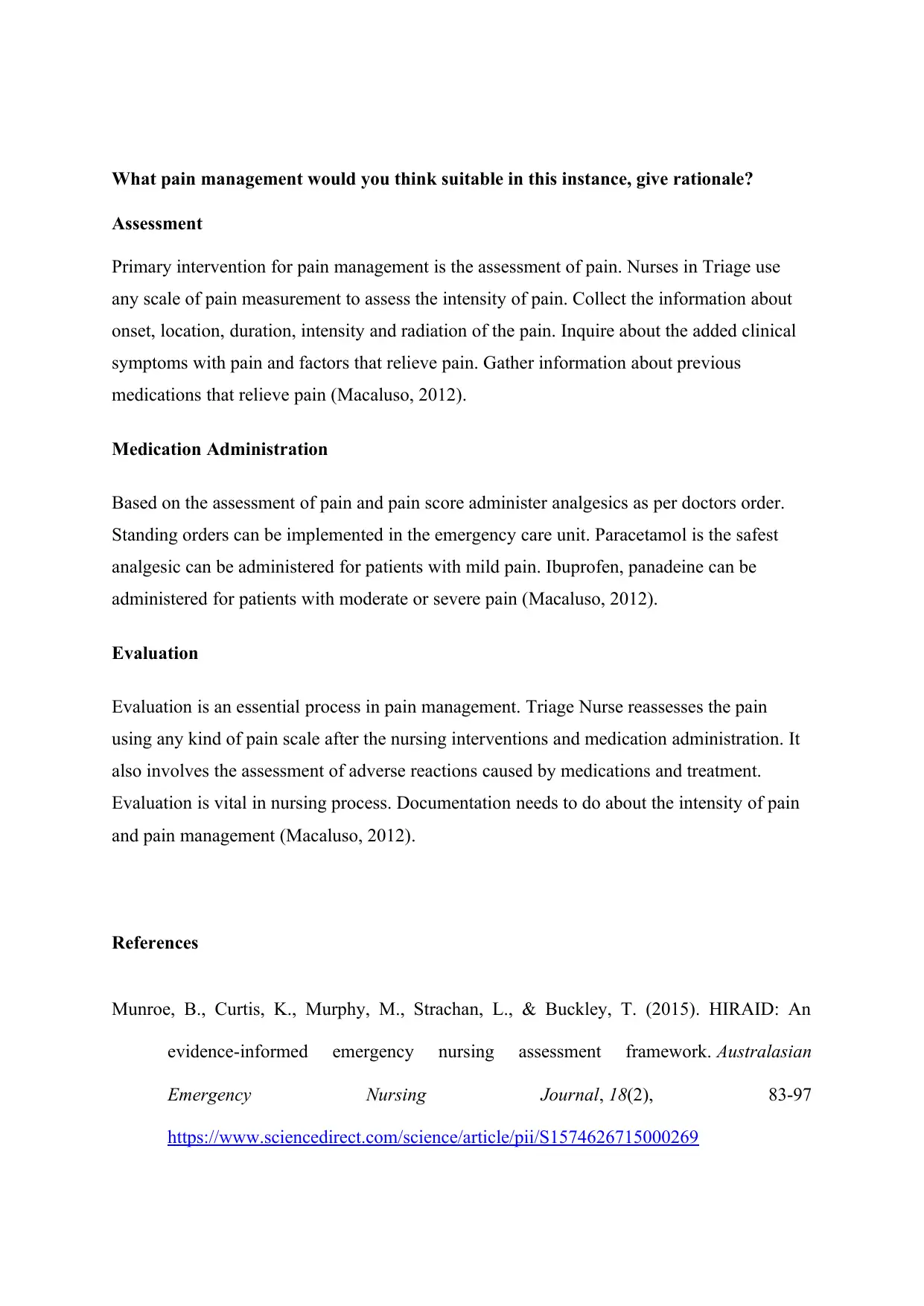
What pain management would you think suitable in this instance, give rationale?
Assessment
Primary intervention for pain management is the assessment of pain. Nurses in Triage use
any scale of pain measurement to assess the intensity of pain. Collect the information about
onset, location, duration, intensity and radiation of the pain. Inquire about the added clinical
symptoms with pain and factors that relieve pain. Gather information about previous
medications that relieve pain (Macaluso, 2012).
Medication Administration
Based on the assessment of pain and pain score administer analgesics as per doctors order.
Standing orders can be implemented in the emergency care unit. Paracetamol is the safest
analgesic can be administered for patients with mild pain. Ibuprofen, panadeine can be
administered for patients with moderate or severe pain (Macaluso, 2012).
Evaluation
Evaluation is an essential process in pain management. Triage Nurse reassesses the pain
using any kind of pain scale after the nursing interventions and medication administration. It
also involves the assessment of adverse reactions caused by medications and treatment.
Evaluation is vital in nursing process. Documentation needs to do about the intensity of pain
and pain management (Macaluso, 2012).
References
Munroe, B., Curtis, K., Murphy, M., Strachan, L., & Buckley, T. (2015). HIRAID: An
evidence-informed emergency nursing assessment framework. Australasian
Emergency Nursing Journal, 18(2), 83-97
https://www.sciencedirect.com/science/article/pii/S1574626715000269
Assessment
Primary intervention for pain management is the assessment of pain. Nurses in Triage use
any scale of pain measurement to assess the intensity of pain. Collect the information about
onset, location, duration, intensity and radiation of the pain. Inquire about the added clinical
symptoms with pain and factors that relieve pain. Gather information about previous
medications that relieve pain (Macaluso, 2012).
Medication Administration
Based on the assessment of pain and pain score administer analgesics as per doctors order.
Standing orders can be implemented in the emergency care unit. Paracetamol is the safest
analgesic can be administered for patients with mild pain. Ibuprofen, panadeine can be
administered for patients with moderate or severe pain (Macaluso, 2012).
Evaluation
Evaluation is an essential process in pain management. Triage Nurse reassesses the pain
using any kind of pain scale after the nursing interventions and medication administration. It
also involves the assessment of adverse reactions caused by medications and treatment.
Evaluation is vital in nursing process. Documentation needs to do about the intensity of pain
and pain management (Macaluso, 2012).
References
Munroe, B., Curtis, K., Murphy, M., Strachan, L., & Buckley, T. (2015). HIRAID: An
evidence-informed emergency nursing assessment framework. Australasian
Emergency Nursing Journal, 18(2), 83-97
https://www.sciencedirect.com/science/article/pii/S1574626715000269
Secure Best Marks with AI Grader
Need help grading? Try our AI Grader for instant feedback on your assignments.
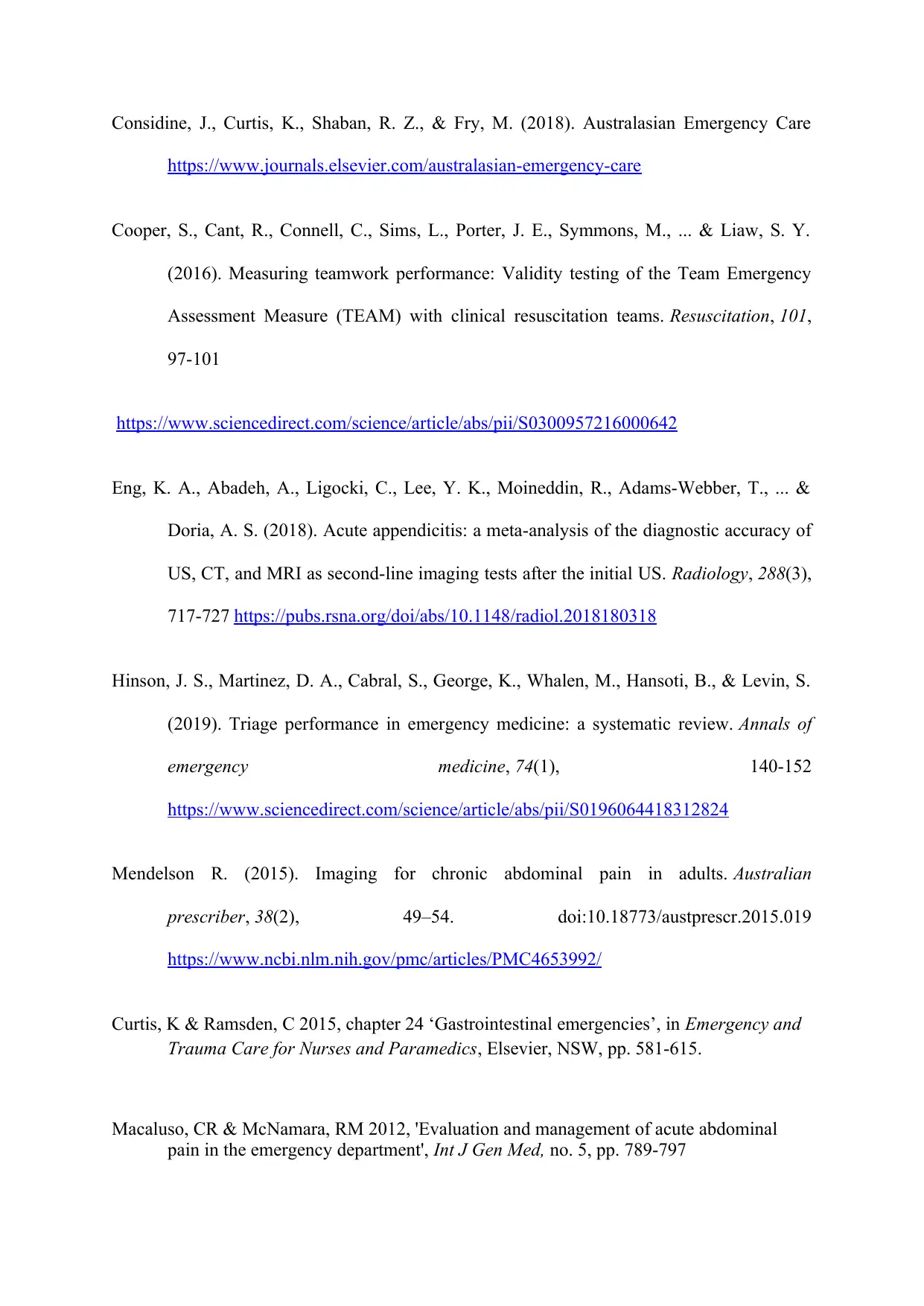
Considine, J., Curtis, K., Shaban, R. Z., & Fry, M. (2018). Australasian Emergency Care
https://www.journals.elsevier.com/australasian-emergency-care
Cooper, S., Cant, R., Connell, C., Sims, L., Porter, J. E., Symmons, M., ... & Liaw, S. Y.
(2016). Measuring teamwork performance: Validity testing of the Team Emergency
Assessment Measure (TEAM) with clinical resuscitation teams. Resuscitation, 101,
97-101
https://www.sciencedirect.com/science/article/abs/pii/S0300957216000642
Eng, K. A., Abadeh, A., Ligocki, C., Lee, Y. K., Moineddin, R., Adams-Webber, T., ... &
Doria, A. S. (2018). Acute appendicitis: a meta-analysis of the diagnostic accuracy of
US, CT, and MRI as second-line imaging tests after the initial US. Radiology, 288(3),
717-727 https://pubs.rsna.org/doi/abs/10.1148/radiol.2018180318
Hinson, J. S., Martinez, D. A., Cabral, S., George, K., Whalen, M., Hansoti, B., & Levin, S.
(2019). Triage performance in emergency medicine: a systematic review. Annals of
emergency medicine, 74(1), 140-152
https://www.sciencedirect.com/science/article/abs/pii/S0196064418312824
Mendelson R. (2015). Imaging for chronic abdominal pain in adults. Australian
prescriber, 38(2), 49–54. doi:10.18773/austprescr.2015.019
https://www.ncbi.nlm.nih.gov/pmc/articles/PMC4653992/
Curtis, K & Ramsden, C 2015, chapter 24 ‘Gastrointestinal emergencies’, in Emergency and
Trauma Care for Nurses and Paramedics, Elsevier, NSW, pp. 581-615.
Macaluso, CR & McNamara, RM 2012, 'Evaluation and management of acute abdominal
pain in the emergency department', Int J Gen Med, no. 5, pp. 789-797
https://www.journals.elsevier.com/australasian-emergency-care
Cooper, S., Cant, R., Connell, C., Sims, L., Porter, J. E., Symmons, M., ... & Liaw, S. Y.
(2016). Measuring teamwork performance: Validity testing of the Team Emergency
Assessment Measure (TEAM) with clinical resuscitation teams. Resuscitation, 101,
97-101
https://www.sciencedirect.com/science/article/abs/pii/S0300957216000642
Eng, K. A., Abadeh, A., Ligocki, C., Lee, Y. K., Moineddin, R., Adams-Webber, T., ... &
Doria, A. S. (2018). Acute appendicitis: a meta-analysis of the diagnostic accuracy of
US, CT, and MRI as second-line imaging tests after the initial US. Radiology, 288(3),
717-727 https://pubs.rsna.org/doi/abs/10.1148/radiol.2018180318
Hinson, J. S., Martinez, D. A., Cabral, S., George, K., Whalen, M., Hansoti, B., & Levin, S.
(2019). Triage performance in emergency medicine: a systematic review. Annals of
emergency medicine, 74(1), 140-152
https://www.sciencedirect.com/science/article/abs/pii/S0196064418312824
Mendelson R. (2015). Imaging for chronic abdominal pain in adults. Australian
prescriber, 38(2), 49–54. doi:10.18773/austprescr.2015.019
https://www.ncbi.nlm.nih.gov/pmc/articles/PMC4653992/
Curtis, K & Ramsden, C 2015, chapter 24 ‘Gastrointestinal emergencies’, in Emergency and
Trauma Care for Nurses and Paramedics, Elsevier, NSW, pp. 581-615.
Macaluso, CR & McNamara, RM 2012, 'Evaluation and management of acute abdominal
pain in the emergency department', Int J Gen Med, no. 5, pp. 789-797

Patton, K &Thibodeau, G 2013, Anatomy & physiology, 8th edn, Mosby Elsevier, USA.
Porth, CM & , Grossman S 2013, Porth's Pathophysiology concepts of altered health states,
9th edn, Lippincott Walters &Kluewer/Williams & Wilkins, Philadelphia.
Porth, CM & , Grossman S 2013, Porth's Pathophysiology concepts of altered health states,
9th edn, Lippincott Walters &Kluewer/Williams & Wilkins, Philadelphia.
1 out of 6
Related Documents
Your All-in-One AI-Powered Toolkit for Academic Success.
+13062052269
info@desklib.com
Available 24*7 on WhatsApp / Email
![[object Object]](/_next/static/media/star-bottom.7253800d.svg)
Unlock your academic potential
© 2024 | Zucol Services PVT LTD | All rights reserved.





